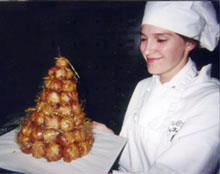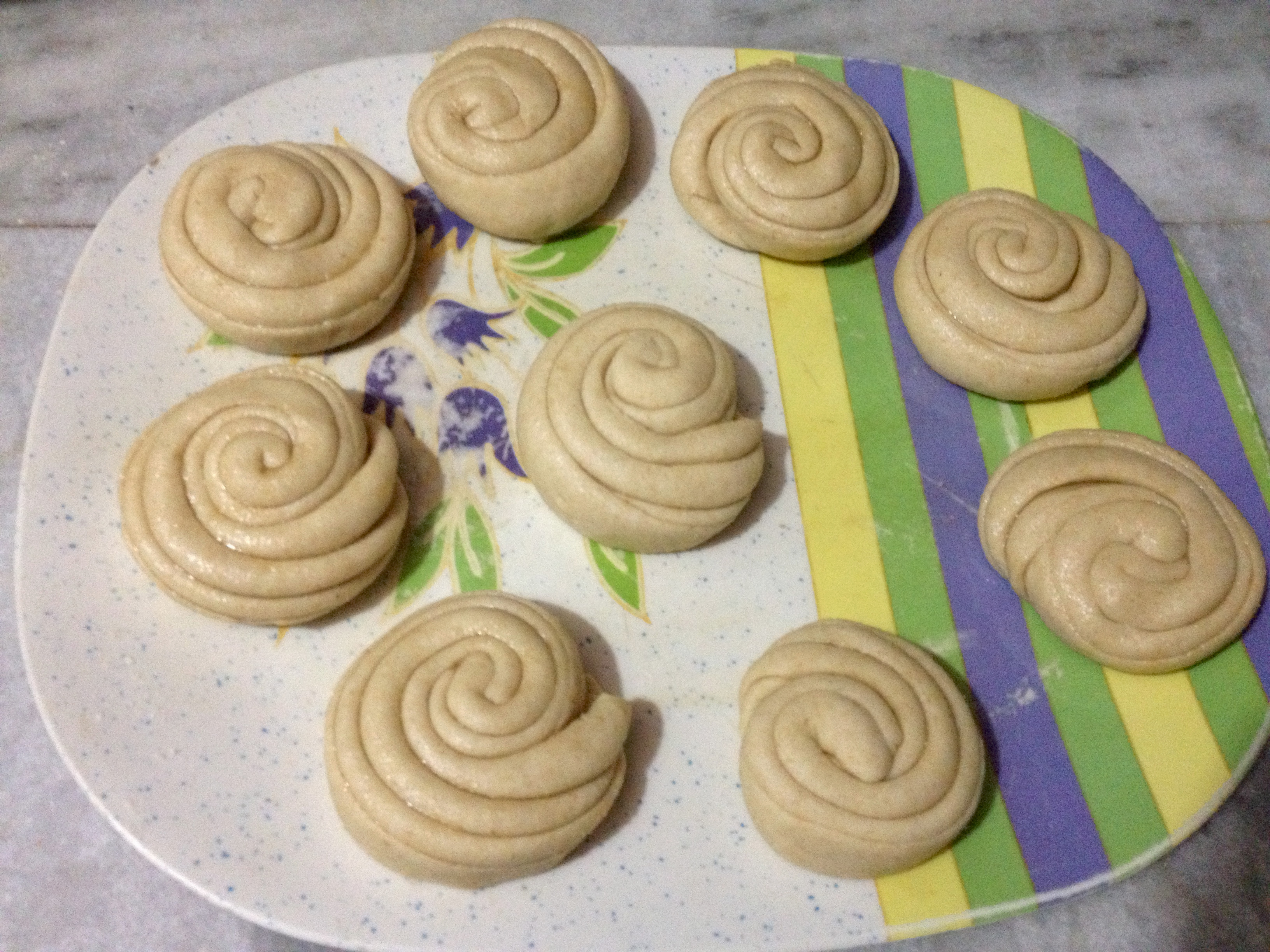|
Dabby-Doughs
Dabby-Doughs are a type of pastry. They are traditionally made using the remnants of dough leftovers from making a pie, although they can be prepared in large amounts by simply making a batch of pastry dough. The filling of a dabby-dough is typically a mixture of cinnamon and white sugar sprinkled on butter or margarine, rolled, sliced and baked. There are many different names for this type of confection, including "cinnamon snails", "schnecken Schnecken are a type of sweet bun or roll of German origin. Today schnecken can be commonly found in Germany, Austria, Switzerland, France, Israel, southern Brazil and the USA. The name ''Schnecken'' means ''snail A snail is, in loose ...", "bumble bees", "pinwheels", "tuzzie-muzzies", "gobblies", "schmekels," "doo-dads" and "mock rugula". References Pastries {{pie-stub ... [...More Info...] [...Related Items...] OR: [Wikipedia] [Google] [Baidu] |
Pastry
Pastry is baked food made with a dough of flour, water and shortening (solid fats, including butter or lard) that may be savoury or sweetened. Sweetened pastries are often described as '' bakers' confectionery''. The word "pastries" suggests many kinds of baked products made from ingredients such as flour, sugar, milk, butter, shortening, baking powder, and eggs. Small tarts and other sweet baked products are called pastries as a synecdoche. Common pastry dishes include pies, tarts, quiches, croissants, and pasties. The French word pâtisserie is also used in English (with or without the accent) for the same foods. Originally, the French word referred to anything, such as a meat pie, made in dough (''paste'', later ''pâte'') and not typically a luxurious or sweet product. This meaning still persisted in the nineteenth century, though by then the term more often referred to the sweet and often ornate confections implied today. Pastry can also refer to the pastry dough, from w ... [...More Info...] [...Related Items...] OR: [Wikipedia] [Google] [Baidu] |
Cinnamon
Cinnamon is a spice obtained from the inner bark of several tree species from the genus ''Cinnamomum''. Cinnamon is used mainly as an aromatic condiment and flavouring additive in a wide variety of cuisines, sweet and savoury dishes, breakfast cereals, snack foods, bagels, teas, and traditional foods. The aroma and flavour of cinnamon derive from its essential oil and principal component, cinnamaldehyde, as well as numerous other constituents including eugenol. Cinnamon is the name for several species of trees and the commercial spice products that some of them produce. All are members of the genus ''Cinnamomum'' in the family Lauraceae. Only a few ''Cinnamomum'' species are grown commercially for spice. ''Cinnamomum verum'' (AKA ''C. zeylanicum''), known as "Ceylon cinnamon" after its origins in Sri Lanka (formerly Ceylon), is considered to be "true cinnamon", but most cinnamon in international commerce is derived from four other species, usually and more correctly refe ... [...More Info...] [...Related Items...] OR: [Wikipedia] [Google] [Baidu] |
White Sugar
White sugar, also called table sugar, granulated sugar, or regular sugar, is a commonly used type of sugar, made either of beet sugar or cane sugar, which has undergone a refining process. Description The refining process completely removes the molasses to give the white sugar, sucrose. It has a purity higher than 99.7%. Its molecular formula is . White sugars produced from sugar cane and sugar beet are chemically indistinguishable: it is possible, however, to identify its origin through a carbon-13 analysis. White sugar (and some brown sugar) produced from sugar cane may be refined using bone char by a few sugar cane refiners. For this reason white sugar from sugar cane may not be vegan. Beet sugar has never been processed with bone char and is vegan. From a chemical and nutritional point of view, white sugar does not contain—in comparison to brown sugar—some minerals (such as calcium, potassium, iron and magnesium) present in small quantities in molasses. The only detec ... [...More Info...] [...Related Items...] OR: [Wikipedia] [Google] [Baidu] |
Butter
Butter is a dairy product made from the fat and protein components of churned cream. It is a semi-solid emulsion at room temperature, consisting of approximately 80% butterfat. It is used at room temperature as a spread, melted as a condiment, and used as a fat in baking, sauce-making, pan frying, and other cooking procedures. Most frequently made from cow's milk, butter can also be manufactured from the milk of other mammals, including sheep, goats, buffalo, and yaks. It is made by churning milk or cream to separate the fat globules from the buttermilk. Salt has been added to butter since antiquity to help to preserve it, particularly when being transported; salt may still play a preservation role but is less important today as the entire supply chain is usually refrigerated. In modern times salt may be added for its taste. Food colorings are sometimes added to butter. Rendering butter, removing the water and milk solids, produces clarified butter or ''ghee'', which is a ... [...More Info...] [...Related Items...] OR: [Wikipedia] [Google] [Baidu] |
Margarine
Margarine (, also , ) is a spread used for flavoring, baking, and cooking. It is most often used as a substitute for butter. Although originally made from animal fats, most margarine consumed today is made from vegetable oil. The spread was originally named ''oleomargarine'' from Latin for ''oleum'' (olive oil) and Greek ''margarite'' ("pearl", indicating luster). The name was later shortened to ''margarine''. Margarine consists of a water-in-fat emulsion, with tiny droplets of water dispersed uniformly throughout a fat phase in a stable solid form. While butter is made by concentrating the butterfat of milk through agitation, modern margarine is made through a more intensive processing of refined vegetable oil and water. Per federal regulation, margarine must have a minimum fat content of 80 percent (with a maximum of 16% water) to be labeled as such in the United States, although the term is used informally to describe vegetable-oil-based spreads with lower fat content. In Br ... [...More Info...] [...Related Items...] OR: [Wikipedia] [Google] [Baidu] |
Pastry
Pastry is baked food made with a dough of flour, water and shortening (solid fats, including butter or lard) that may be savoury or sweetened. Sweetened pastries are often described as '' bakers' confectionery''. The word "pastries" suggests many kinds of baked products made from ingredients such as flour, sugar, milk, butter, shortening, baking powder, and eggs. Small tarts and other sweet baked products are called pastries as a synecdoche. Common pastry dishes include pies, tarts, quiches, croissants, and pasties. The French word pâtisserie is also used in English (with or without the accent) for the same foods. Originally, the French word referred to anything, such as a meat pie, made in dough (''paste'', later ''pâte'') and not typically a luxurious or sweet product. This meaning still persisted in the nineteenth century, though by then the term more often referred to the sweet and often ornate confections implied today. Pastry can also refer to the pastry dough, from w ... [...More Info...] [...Related Items...] OR: [Wikipedia] [Google] [Baidu] |
Dough
Dough is a thick, malleable, sometimes elastic paste made from grains or from leguminous or chestnut crops. Dough is typically made by mixing flour with a small amount of water or other liquid and sometimes includes yeast or other leavening agents, as well as ingredients such as fats or flavorings. Making and shaping dough begins the preparation of a wide variety of foodstuffs, particularly breads and bread-based items, but also including biscuits, cakes, cookies, dumplings, flatbreads, noodles, pasta, pastry, pizza, piecrusts, and similar items. Dough can be made from a wide variety of flour, commonly wheat and rye but also maize, rice, legumes, almonds, and other cereals or crops. Types of dough Doughs vary widely depending on ingredients, the desired end product, the leavening agent (particularly whether the dough is based on yeast or not), how the dough is mixed (whether quickly mixed or kneaded and left to rise), and cooking or baking technique. There is no formal ... [...More Info...] [...Related Items...] OR: [Wikipedia] [Google] [Baidu] |
Confection
Confectionery is the art of making confections, which are food items that are rich in sugar and carbohydrates. Exact definitions are difficult. In general, however, confectionery is divided into two broad and somewhat overlapping categories: bakers' confections and sugar confections. The occupation of confectioner encompasses the categories of cooking performed by both the French ''patissier'' (pastry chef) and the ''confiseur'' (sugar worker). Bakers' confectionery, also called flour confections, includes principally sweet pastries, cakes, and similar baked goods. Baker's confectionery excludes everyday breads, and thus is a subset of products produced by a baker. Sugar confectionery includes candies (also called ''sweets'', short for ''sweetmeats'', in many English-speaking countries), candied nuts, chocolates, chewing gum, bubble gum, pastillage, and other confections that are made primarily of sugar. In some cases, chocolate confections (confections made of chocolate) ... [...More Info...] [...Related Items...] OR: [Wikipedia] [Google] [Baidu] |
Schnecken
Schnecken are a type of sweet bun or roll of German origin. Today schnecken can be commonly found in Germany, Austria, Switzerland, France, Israel, southern Brazil and the USA. The name ''Schnecken'' means ''snail A snail is, in loose terms, a shelled gastropod. The name is most often applied to land snails, terrestrial pulmonate gastropod molluscs. However, the common name ''snail'' is also used for most of the members of the molluscan class Gastro ...s'' in German and refers to the shape of the pastry. The bun is still common in Germany and Austria (in some regions as ''Schneckennudel''), where the name is ''Schnecke'' (which is the German singular of ''Schnecken''), and in other parts of northern Europe. They are more commonly known as ''escargots'' (snails) or ''pain au raisin'' in France. Popular variants are Nussschnecken (filled with nuts and often raisins as well), Mohnschnecken (with a poppyseed filling) and Zimtschnecken, which are quite similar to cinnamon r ... [...More Info...] [...Related Items...] OR: [Wikipedia] [Google] [Baidu] |





